Horizontal heating system: features of the device
Horizontal wiring of the heating system has long been widely used throughout the world. In our country, it is just beginning to be successfully implemented in new buildings. What is it so attractive and what types it happens, we consider in this article.

Principles of operation

The system under consideration has the following structural composition:
| Item Name | Description and Purpose |
| Feed Rack | It is located in the entrance or a special technical room, supplies a heated coolant |
| Riser outlet | Located in the entrance or a special technical room, displays already cooled coolant |
| Collector | Installed on each floor and spreads the system for apartments |
| 2 valves | Installed on each apartment, allowing you to control the flow of coolant |
| Feed tube | Provides a heated coolant radiator, hiding in the floor screed |
| Return pipe | Removes cooled coolant, hides in floor screed |
| Radiator | Heats the room |
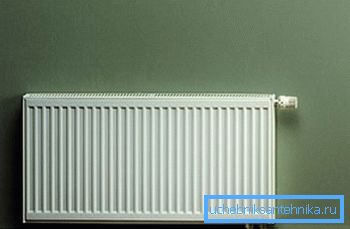
Types of wiring
Depending on its design, the horizontal wiring of heating can be:
Single pipe
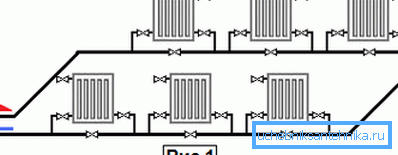
As can be understood from the figure, in this embodiment, the warm and cold liquid passes through the same pipe, and the radiators are connected in series with respect to each other.
Of course, the price of this design is much lower due to the economy of materials, but also some tangible drawbacks emerge:
- The water cools over that period until it passes through the entire circuit, which significantly reduces the efficiency and increases the cost of heating the room..
Tip: It is recommended to limit the use of such systems in small private homes. In them, the heating circuits are not so large as to fully experience the premature loss of heat from the coolant.
- The tangible difference between the temperatures of the first and last radiators in the circuit. This negatively affects the uniform distribution of heat.
- The complexity of the adjustment of their own hands. Each change in the operation of one of the radiators will affect the functioning of all the others.
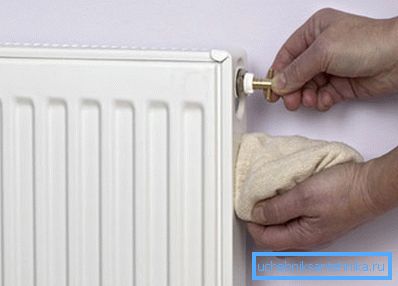
- Inconvenience in carrying out repairs, since even the smallest restoration will require shutting down the entire system.
Twin tube

There are already a lot of advantages over the previous version, and the potential of horizontal wiring is fully realized:
- The liquid flowing through the batteries does not have time to cool down., since the flow of coolant occurs on one pipe, and the discharge of the cooled water - on the other.
- Radiator heats up in parallel, what gives the chance to achieve on them identical temperature, and, therefore, the best microclimate in the house.
- The ability to control temperature. This allows more economical use of the heating system, reducing its power during periods of warming outside.
Double tube beam
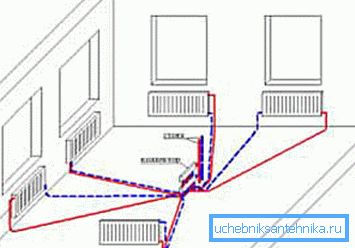
It is collector, as it provides for the installation of a collector in each apartment, which will distribute the flow of coolant to each radiator individually.
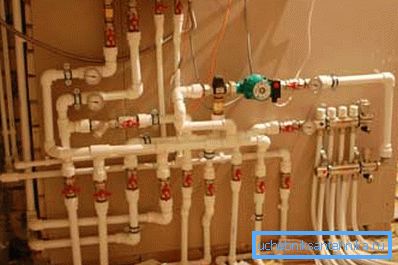
This layout of pipes though has several drawbacks:
- A large number of materials, which greatly increases the cost of the system.
- The need for circulating pumps.
But a large number of advantages still makes it the most progressive and popular:
- The admissibility of adjusting the performance of each radiator individually. This provides unique opportunities to control the microclimate of your home.
- Each of the circuits is a self-contained closed system.. They can be equipped with additional devices, and if necessary, repairs will not be required to turn off all the heating, it will be enough to cut off the desired battery.
- No vent on radiators, they are already on the manifold.
Tip: it is also recommended to install heat consumption meters immediately. They will allow to take into account only the heat that you need, so that you will not need to pay for an overheated room.

General characteristics
So many advantages, but what's the catch? Let's take a look at the economic aspect of horizontal heating:
Saving
In comparison with traditional vertical systems, the design under consideration is more expensive, in particular, it concerns the two-tube beam distribution. But long-term research in this area shows that it pays off in the first two or three years. What makes this happen?
Let's get a look:
- About twenty percent of the cost of all installation work is paid by the developer, since the heating pipes are laid in the floor screed when it is poured.
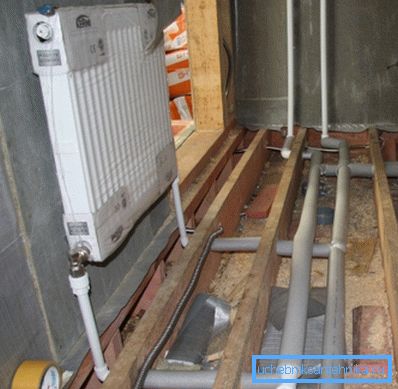
- Regulation of the power of the radiators gives savings in warm weather.
- Reducing the number of accidents and leaks also allows you to save the family budget for calls plumbers.
- Used plastic pipes are much cheaper than steel pipes.
Minimum protruding elements

Separately, it is worth paying attention to the fact that the pipes supplying the coolant are hidden in the floor screed. Due to this, the following advantages can be distinguished:
| Dignity | Description |
| Aesthetics | Designer repairs are quickly gaining popularity, and not everyone wants to see metal risers in their homes. In this case, this problem is completely solved, all wiring is hidden in the floor and does not interfere with the interior. |
| Security | Especially true in the case of the presence in the house of small children. Exposed steel pipes can often cause burns or physical injury. |
| Practicality | The life of a polypropylene pipeline, hidden in concrete, reaches fifty years, they are not susceptible to corrosion and elastic. All these qualities put off the possibility of a leak for an indefinite period. |
Installation
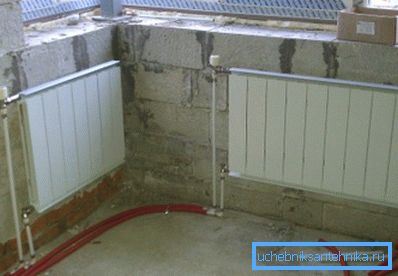
Immediately it should be noted that the instructions for installing a horizontal heating system are rather complicated and it is not recommended to perform the work yourself.
This is due to the following reasons:
- The complexity of the necessary calculations and design, which only a professional engineer can.
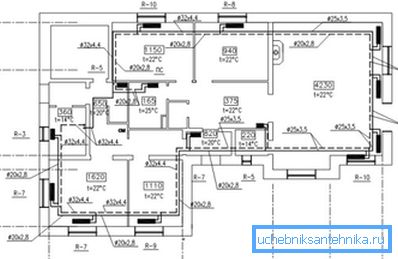
- Directly for installation, start-up and debugging, you also need to have relevant experience and knowledge of the latest standards, which in our area are only being integrated.
- The need to confirm the implementation of all necessary standards by government experts who must register all heating equipment.
Any error in the project or at the connection stage may entail additional costs that will exceed the payment for the work of hired professionals, so think a few times before undertaking the installation of a horizontal heating system on your own.
Conclusion
Horizontal heating systems are in many ways superior to traditional vertical wiring. They have better performance, higher reliability, the ability to control performance and many other technical advantages. And even their higher cost with interest pays off in the first years of operation.
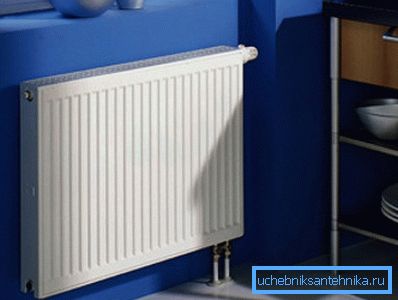
On the provided video you will be able to get acquainted with additional materials that are directly related to the stated topic. Choose only the best for your home!